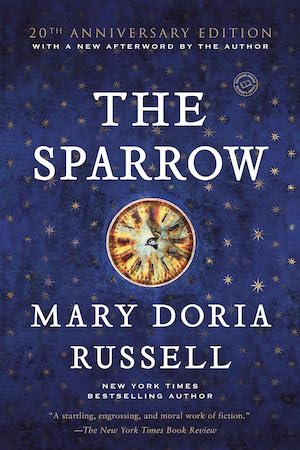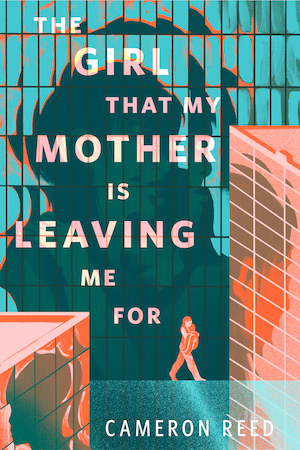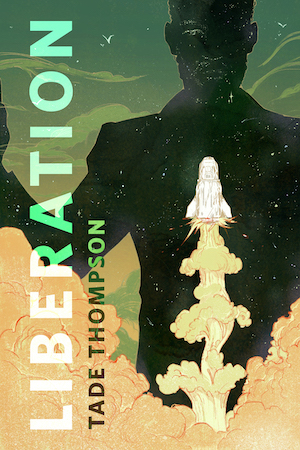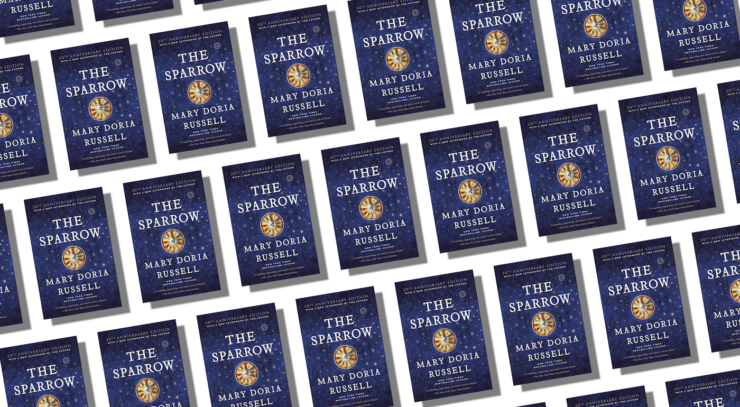In 1996, Mary Doria Russell’s debut novel, The Sparrow, was released to strong reviews and multiple awards including an Astounding Award for Best New Writer, an Otherwise Award, and an Arthur C. Clarke Award. The book tells the story of Father Emilio Sandoz, a Jesuit priest and linguist who is the only surviving member of a mission to the planet of Rakhat—the first voyage Earthlings have ever made to another inhabited planet. After Emilio comes back to Earth, he faces a tribunal to explain what happened to everyone else. The Sparrow is a fascinating, troubling, often heartbreaking work of sci-fi. While not all of it has aged perfectly (there are a lot of broad cultural assumptions made) its exploration of faith and first contact is still extremely moving.
The book jumps between several different time periods: 2014-2019, when Emilio Sandoz meets the people who become his best friends and eventual crew on the mission to Rakhat; 2020-2022, when the crew travels toward Rakhat; the nebulous time on Rakhat, which would have felt like a few years in the mid-late 2020s to Emilio and his crew, but is the equivalent of about 40 years back home; and 2060, when Emilio returns as the sole survivor of the mission. Because of these time jumps, we get to see quite a bit of Russell’s imagined future.
Inventing a future is always tricky. You can end up with a situation like Super Sad True Love Story or A Visit from the Good Squad, where the worldbuilding is solid but you also have to invent teen slang and trends, when teen slang and trends are the most changeable things in the world and no one can ever possibly get them right. You can end up in the Infinite Jest situation, where the author puts all his chips down on one particular piece of tech—in this case “cartridges”—and makes them a fulcrum for his plot, only to watch the rise of discs and then streaming make his vision of the future seem impossibly retro. Russell ducks a lot of these issues by making most of her characters priests, and sequestering them in a couple of specific locations—in one case, a newly-discovered planet; in the other, a rural Italian retreat house—where slang and internet trends simply don’t come up. But you can’t avoid all tech, and as I was torturing myself with a reread recently (the book is good, but if you love Emilio Sandoz—and you probably will—this book is not a light read) I found myself noticing her predictions, and I thought it would be fun to look at some of what she got right and some of what she missed.
Buy the Book


The Sparrow
AI is coming for your job
When we meet Jimmy Quinn, the young NASA employee who first identifies the alien communication from Rakhat, he’s just been assigned a “vulture”. In the parlance of The Sparrow’s version of 2019, a “vulture” is basically a human AI scraper: a person who interrogates a specialist about the inner workings of their job to see how much of it, if any, can be encoded and turned over to machines. If it works, that specialist and their fellows are out of work. Because of that, vultures are not particularly well-liked.
Private interests… in… spaaaace
In the 2020s of The Sparrow, mining corporations (mostly Australian for some reason?) have begun harvesting and mining asteroids. Once an asteroid is partially hollowed out, a corporation with enough money could, theoretically, use the husk as a ship for space exploration. This is precisely what the Jesuits do, sending Emilio and his crew to Rakhat on a privately funded mission that doesn’t have to answer to any particular government or even the UN. Soon thereafter, at least one private firm called “the Contact Consortium” also sends an asteroid, more interested in establishing trade with the people of Rakhat than in the “Science, with, perhaps, a small scoop of proselytizing” mission that the Jesuits organized.
Portable digital reading devices
Russell doesn’t make a big deal out of it, but in the 2016-2019 sections of the book, everyone seems to use “tablets”, which I can only see as a flat portable reading device like an iPad, which people can write on directly using stylus. In the 2060 section, the (I assume updated) version is called a “notescreen”, and at one point someone leaves “an old ROM periodical” out for Emilio, who’s 40 years behind the times. None of these tablets are referred to by brand names, and they seem to be able to connect to the internet, referred to solely as “the net”, without anyone making a big deal about wires or wifi.
And about that “net”
At a pivotal point, one character tells another to “get on the net” and they reply “No, virtual reality isn’t good enough, I want reality reality”—which implies that there are video chatrooms available for people to share, à la our current use of Zoom and Google Meet. There is also a moment when one character pays extra to make an important videocall to his friends rather than settle for a regular telephone call.
Normcore?!!
I’ll admit this is a little bit of a stretch. In 2015, a few years before the mission to Rakhat, Father Emilio Sandoz is sent to work with a vulture in Cleveland. He meets the woman in a coffeeshop near the college campus, and is struck by the fashions of the youth, which is made particularly noticeable because he’s been working at a refugee camp at the edge of a war zone for a year. He looks at the sea of young people:
“…the young men in brilliantly colored, intricately pleated coats that broadened shoulders and narrowed hips, the young women wasp-waisted and delicious in pale and shimmering fabrics the colors of peony blossoms and sherbet.” (34)
When I revisited the book recently, I was struck by the similarity to the fashions of 2013’s Her, set in a near-future, which itself tapped into the then-popular style known as normcore.
HIV is no longer a death sentence
A few pages after the invention of Normcore, and still firmly in 2014, Sandoz makes a passing mental reference to people with “chronic HIV”. Meanwhile HIV was still the #1 cause of death for young Americans in the 1990s, and by 1996 HIV was only barely treatable, with complicated drug cocktails that could hold AIDS at bay for varying amounts of time, but which were no guarantee of a long life. But by the early 2010s better cocktails and PrEP became increasingly available, matching Russell’s timeline almost exactly.
But Russell didn’t get everything right, and I picked out three things in particular that she missed.
Whither Television?
When Emilio’s friend George Edwards meets freelance vulture Sofia Mendes in 2019, he’s unsure of her age, and wonders if she’s too young to remember TV. It turns out that she’s 29 at that point, which would mean she was born in 1989/90. Even if we want to say that The Sparrow is an AU, I find it fascinating to think that someone the same age as Taylor Swift wouldn’t “remember” TV—did all network television simply die out in the early ‘90s? Because people know movies! Emilio seems to have a surprisingly thorough knowledge of films that would have been old when he was a kid, and there are a weird number of references to Young Frankenstein scattered throughout this book. So how were people watching these movies if no one had TV anymore? But it is worth noting that when people gather together in the book, it’s always either at bars, or for dinner parties. There are no movie marathons, no Oscar parties, no Sunday afternoons in front of a baseball or fútbol game.
And furthermore, where are the cellphones?
There aren’t any! As I was reading the book again something kept nagging at me, and I finally realized that no one in the book carried a phone on them. They made calls from landlines, and sent messages—video and text—over the internet, but there was no indication that any company had made the now-obvious jump to selling pocket computers that are also phones. As a person who was a late cellphone adopter—I think I held out until 2005—this was an eerie glimpse into a different world where we could walk away from the internet, our jobs, constant contact with everyone we’ve ever known… but also got lost more often, I guess.
And finally…
We actually did something about climate destruction???
In 2019, Emilio lives in a free apartment because it’s so close to the coast no one else is brave enough to live in it, implying that the sea levels are rising pretty rapidly. However, in the 2060 sections we learn that, at least in Italy, wood fires are illegal (a priest wonders if the next Papal Election will be announced via a digital sign reading “White Smoke” rather than using actual smoke) and private vehicles aren’t allowed inside city limits. Russell makes a point of mentioning the various plants blooming over a few months’ time in the books to mirror Emilio’s slow healing process, but it also shows us that plants are thriving in a future that, seemingly, halted climate destruction. There are also still bees!
That’s what I found on my most recent re-read—for those of you who have read the book, did I miss anything that jumped out at you? What are your favorite literary futures? And will we ever live in a future where The Sparrow is adapted to TV, in whatever form that medium exists?











I first found The Sparrow in my high school library in 2019. In between getting mildly traumatized and majorly invested in the ways first contact can go sour, I remember how ironic I found the video call booths to be. Great read!
Also, it pairs well with A Canticle for Leibowitz! Sci-fi + Man’s hubris + priests + simple Latin for classics nerds to feel smug about understanding
Couldn’t finish this one.
My main issues was how were they doing this trips to another solar systems? Maybe I misses the “thingamy” drive but it was just too much of an issues for me.
I’ve said this on a few threads. I hated the sparrow, and i’ve read it a few times. Even read one of the sequels that came out a few years ago. This was assigned to me in an undergrad course on science fiction (also the same course that got me to finally read Frankenstein, now there’s a home run and a half…).
Anyways, first I’m an atheist, and just couldn’t feel the “this book brings you to god” element. Meh. They were humans, they made decisions, and some of them quite shitty, so when their mission went off the rails, that’s on them, man.
Second, and this was one of my key, wtf points with the book: WHY THE HELL ARE JESUITS THE PROPER PEOPLE TO DO FIRST CONTACT? Did Russell not read bartholomew de las casas or know any history of the Americas at all? What about reading chinua achebe’s work? GRRRR
Jesuits are especially interested in science above all other orders. It’s in their DNA, if you will. They are still running the Papal observatory and have among others also sent an expedition to record a Venus transit in the later 1700s of which father Maximilian Hell (there’s your HELL, after all…) was the head.
So, if I selected any priest for exploring other worlds, it would be a Jesuit, although I acknowledge your general points regarding their history.
Chaironea, Thank you for that response. It does explain the general sense of my question properly, but again, it’s the history and not the theoretical idea of jesuit explorers, which was the focus of my question
I’m with you. This book was highly recommended by my partner at the time as well as many other people (which in retrospect probably didn’t help with the expectation bias,) and when i finally got around to reading it i was incredible disappointed.
It was supposed to have this “surprising” twist(s), but anyone familiar with the history of missionaries in our world would expect that an independent mission by them with naive expectations was going to screw things up by the numbers, and the foreshadowing (preshadowing?) from the future sections made it more and more apparent that those expectations were not going to be subverted.
When the final “twist” was revealed it was like, that sucks for you personally dude, but what did you expect when setting out on a first contact missions with no authorization, no military backup, and no realistic plan to a planet that’s not technologically advanced enough to realize how badly an (even barely) interstellar civilization could mess your entire planet up if they decided to take offense at mistreatment of their (unofficial and unsanctioned) envoys?
I was expecting a sh*t show from the get go, i got a sh*t show, and i was neither surprised nor especially moved by the tragic banality of it all.
Okay, this discussion has gotten the book stuck in my head so i have one more thing to say to try and kill the brainworm.
This book has some science and world building, and that part is interesting enough. This book has a lot to say about faith, and i’ve definitely enjoyed that in other books in the past. (“A Case of Conscience”, “A Canticle for Leibowitz”, “Calculating God” (even though i disagree with some of the assumptions), and even “Speaker For the Dead” (even though i no longer hold that author in high regard.)
But that faith is tied up in, and the book is really all about, the big “twist”. The book constantly hints about it and builds up to it, and as a result the people who really like the book tend to hype that part up as well.
The thing about having a twist but also foreshadowing it is that if the people reading it say “it sounds like something involving x, and that would be terrible”, you may have a good book on your hands. This is doubly the case where the narrative alternates between “foreshadowing” of the twist in the future and building up to the twist in the past. (I can think of one book in particular that does this pretty competently which i won’t name for spoiler reasons.)
But if the people reading the book say “it sure sounds like something involving x, but that would be dumb, because it would be stupid for everyone to react to it that way, so it must be something else”, but in the end it turns out it _was_ x, and everyone _is_ being stupid, then it’s not very satisfying.
And yes the Catholic church has a well known history of “holier than thou” victim-blaming in the past, but even so it’s unbelievable that they would fall back on such behaviour in such a unique and important situation given the evidence on hand, and maintain that assumption for so long with zero introspection or investigation up until the start of the book. Especially given how dedicated the church was to this project and the enormous amount of resources that were poured into it.
Maybe if you’re shocked at the idea that the Catholic church could behave in such a way in general then the twist reveal seems to be amazing. But if you already lack faith (hah) in the church then it’s just frustrating how much they’re playing to a stupid stereotype. And even more frustrating that you feel like so much time and anticipation was wasted on such an anti-climax.
And even the bit about the protagonists struggles with and testing of his faith are pretty meaningless to me. I already believe that bad stuff happens to people for no good reason, and no amount of faith or prayer are going to prevent it or explain it.
So for me there’s nothing shocking or engaging about a bunch of people doing dumb things because of their faith and bad assumptions, having things turn out tragically bad (in large part exactly because they were dumb decisions based on bad assumptions) and the church handling the results incompetently.